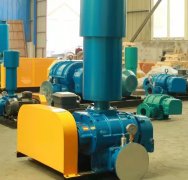Roots vacuum pump fan
Roots vacuum pump, also known as Roots blower or Roots blower, is an important vacuum equipment that extracts air by a pair of rotors rotating relative to each other inside the pump chamber. The following is a detailed introduction to the Roots vacuum pump fan:
1、 Working principle
The working principle of Roots vacuum pump is mainly based on the relative rotational motion of the rotor inside the pump chamber. The pump is equipped with two rotors, which maintain clearances between them and the inner wall of the pump casing. Through the rotation of the rotor, gas is drawn in from the inlet, and then compressed and discharged from the outlet. During the rotation of the rotor, due to the special design of the rotor profile (the rotor cross-section is an arc, circular arc or involute), the gas inside the pump chamber is effectively compressed and discharged, thereby achieving vacuum extraction.
2、 Structural characteristics
The structure of Roots vacuum pump mainly includes pump body, rotor, transmission device, bearings, sealing device and other parts.
1. Pump body: usually made of cast iron or cast steel material, with good strength and sealing performance.
2. Rotor: The core component of Roots vacuum pump, its profile design and machining accuracy directly affect the performance and service life of the pump.
3. Transmission device: It is usually driven by a motor or reducer to make the rotor rotate relative to each other in the pump chamber.
4. Bearing: Responsible for supporting the rotational motion of the rotor, high-precision bearings are usually used to ensure the stable operation of the rotor.
5. Sealing device: used to ensure that the gas inside the pump chamber does not leak into the external environment, usually using mechanical seals or dry gas seals.
3、 Main performance parameters
The main performance parameters of Roots blower include speed, pressure, flow rate (air volume), shaft power, and exhaust temperature.
1. Speed: The speed at which the active shaft of the blower rotates per unit time, usually in r/min.
2. Pressure: The gas pressure at the inlet and outlet flanges of the blower, divided into inlet pressure and outlet pressure, commonly measured in Pa or kPa.
3. Flow rate: The mass or volume of gas passing through a specified section of a blower per unit time is called the mass flow rate or volume flow rate of gas passing through that section, commonly measured in m3/s or m3/min.
4. Shaft power: The power transmitted from the prime mover to the active shaft of the blower, commonly measured in W or kW.
4、 Performance curve
The performance curve of Roots blower mainly includes the curve Q-P of the relationship between air volume (Q) and pressure (P) changes, as well as the curve N-P of the relationship between shaft power (N) and pressure changes. At the rotational speed, when the pressure change of the Roots blower is large, the change in air volume is very small and basically remains unchanged. This indicates that Roots blowers are particularly suitable for situations where pipe network resistance is variable and air flow requirements are basically stable. The shaft power increases with the increase of pressure, which helps to determine the appropriate shaft power based on the required pressure and air volume during selection, thereby avoiding excessive energy consumption.
5、 Application Fields
Roots vacuum pumps have the advantages of large pumping capacity, high vacuum degree, stable and reliable operation, low vibration, and low noise. Therefore, they are widely used in various industrial fields that require processing large amounts of gas and low vacuum degree requirements, including:
1. Petrochemical industry: used for processes such as vacuum distillation and vacuum drying in petroleum refining and chemical production.
2. Metallurgical industry: used for processes such as metal smelting and vacuum smelting.
3. Power industry: Vacuum systems used for power plant turbines, gas turbines, and other equipment.
4. Pharmaceutical and environmental protection industries: used for vacuum extraction and gas treatment in pharmaceutical production, wastewater treatment, and other processes.
5. Other fields: It is also applied in vacuum casting, vacuum melting, vacuum degassing, vacuum coating industry, as well as pesticide, turbine rotor dynamic balancing, aerospace space simulation and other devices.
6、 Maintenance and upkeep
In order to ensure the normal operation and prolong the service life of Roots vacuum pumps, regular maintenance is required. In addition, when using a Roots vacuum pump, the following points should be noted:
1. It should be ensured that there are no impurities or moisture inside the pump body to avoid affecting the performance and service life of the pump.
2. Excessive temperature and pressure inside the pump chamber should be avoided to prevent damage to the pump body and rotor.
3. The operation of the motor should be regularly checked to ensure that it can drive the rotor to rotate normally.
4. When shutting down, the inlet and outlet valves should be closed first, and then the power should be cut off to ensure the pump's shutdown.
In summary, Roots vacuum pump fans, as an important vacuum equipment, have a wide range of applications and important positions in industrial production.



